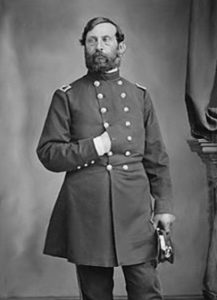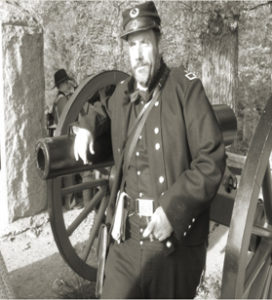Henry Jackson Hunt was born September 14, 1819 in Detroit, Michigan, the son of Samuel Hunt, a career army infantry officer.

He graduated from the United States Military Academy in the class of 1839, finishing 19th out of 31 cadets, and was brevetted a 2nd Lieutenant in the 2nd U.S. Artillery. He served in the Mexican War under Winfield Scott and was appointed a brevet Captain for gallantry at Contreras and Churubusco, and to Major at Chapultepec. Hunt served with the same unit during the Utah War in 1857 against the Mormons.
Prior to the start of the Civil War, his most distinguished service was probably as a member of a three-man board that revised field artillery drill and tactics for the army. The Instructions for Field Artillery manual was adopted by the War Department in 1860 and became the “bible” of Northern field artillerists during the war. He was a principal proponent of the organizational doctrine that allowed infantry brigades to retain artillery batteries for close-in support, but that moved batteries formerly assigned to divisions and corps to an Artillery Reserve at the army level for more strategic control.
Hunt achieved initial recognition in the Battle of 1st Bull Run in 1861, when his four-gun battery covered the retreat of a Union force with a close-in artillery duel. He soon afterward became chief of artillery of the Washington city defenses.
As a Colonel on the staff of Major General George McClellan, Hunt organized and trained the artillery reserve of the Army of the Potomac and fought with it in the Peninsula Campaign. At the Battle of Malvern Hill, his 250 guns shattered repeated Confederate infantry assaults. He personally commanded a group of 60 guns that he employed as if they were a single battery (usually Union batteries contained six guns).
On September 15, 1862, the day after the Battle of South Mountain, Hunt was promoted to Brigadier General of Volunteers and McClellan assigned him as Chief of Artillery of the AoP for the Battle of Antietam, where he deployed the Artillery Reserve to great effect. At the Battle of Fredericksburg in December, his gun emplacements on Stafford Heights effectively eliminated any possibility that Gen. Robert E. Lee could counterattack Union forces across the Rappahannock River.
On the eve of the Battle of Chancellorsville in May 1863, Hunt fell out of favor with the AoP commander, Maj. Gen. Joseph Hooker, and lost direct command of the Artillery Reserve, resulting in his being reduced to an administrative staff role. The lack of coordination of the artillery forces that followed from this move were deemed by some as a contributing factor in the embarrassing Union defeat. Subsequently, Hooker restored Hunt to the command of the artillery.
Hunt’s most famous service in the war was at the Battle of Gettysburg in July 1863. His new commander, Maj. Gen. George Meade, greatly respected Hunt’s expertise and not only gave him great latitude in directing the artillery, but also used him on occasion as his personal representative. For example, on July 2, Meade sent Hunt to 3rd Corps commander Maj. Gen. Dan Sickles in an attempt to get Sickle’s defensive lines to conform to orders. (Sickles’ insubordinate movement from Cemetery Ridge, where he had been ordered to defend, to the Peach Orchard, broke the continuity of the Union defensive line.) Hunt was unable to influence Sickles’s deployment, but Hunt’s masterful analysis of terrain and placement of batteries on the ridge were important factors in the Union’s eventual success on the second day.
His handling of the artillery was conspicuous in repelling Pickett’s Charge on July 3. With the Union line on Cemetery Ridge under massive bombardment, Hunt was able to resist command pressure that would have expended all his ammunition in counter-battery fire, reserving sufficient amounts for anti-personnel fire in the attack he knew was coming. His orders to cease firing (despite the strong orders of fiery 2nd Corps commander Maj. Gen. Winfield Hancock) deceived the Confederates into thinking the Union batteries were heavily damaged and informed their decision to stage their disastrous charge. His concealed placement of Lt. Col. Freeman McGilvery’s batteries north of Little Round Top caused massive casualties in the Confederate charge.
General Hunt served in Virginia to the end of the war, managing the artillery during the Siege of Petersburg in 1864 and 1865. He attained the brevet ranks of Major General of Volunteers and Brigadier General in the regular army.
When the U.S. Army was reorganized in 1866, Hunt became Colonel of the 5th U.S. Artillery and president of the permanent Artillery Board. He held various commands until 1883, when he retired to become governor of the Soldiers’ Home in Washington, D.C. He is considered by his contemporaries to be the greatest artillery tactician and strategist of the war, a master of the science of gunnery, who rewrote the manual on the organization and use of artillery in early modern armies. His courage and tactics affected the outcome of some of the most significant battles in the war.
Although acknowledging the power of massed batteries to repel infantry assaults (such as at Malvern Hill and Pickett’s Charge ) he urged his gun crews to fire slowly and deliberately and reprimanded them if they exceeded an average of one shot per minute. He believed that faster rates impaired accurate targeting and depleted ammunition faster than could be replenished. A story often told about Hunt was when he exclaimed to a gunner of a fast-firing gun, “Young man, are you aware that every round you fire costs $2.67?”
He died on February 11, 1889, at age 69, in Washington, D.C and is buried in the Soldiers Home National Cemetery.

John Mills
John has been a Civil War buff for many years and resides in Levittown, PA.
John Mills can be contacted at henry.hunt@uniongenerals.org